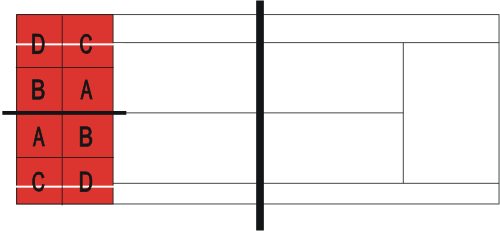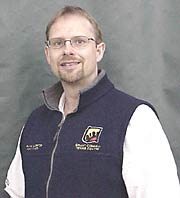|
TennisOne Lessons Progressive Tennis: ½ Court Tracking, Catching & Throwing Skills Wayne Elderton In the last article (“Progressive Tennis: Starting Players at 1/2 Court”), we looked at the contrast between a traditional beginner process (feeding balls so players can groove strokes), and a Game-based approach. In a GBA, players start with the tactic of a consistent neutral exchange (rally). They then learn the technical elements required for successfully rallying by ‘shaping’ the shots out from the impact point. GBA: An approach that doesn't teach technique? This leads to a little side bar. As the GBA becomes known, and coaches experiment with the process, resistance by traditional coaches becomes inevitable. One of the most common complaints about GBA is that it doesn't teach technique. Unfortunately, this observation is all too often true with coaches who have not mastered a GBA.
When coaches begin to explore a GBA, they get occupied dealing with the greater organizational demands of the approach (organizing all players to be active is far more difficult than putting people in lines). They get drawn into the tactics and process of getting learners to play so much that they loose sight of technical development. Also, since they typically have abandoned the inferior "model" method as a technical approach, they have few tools to apply to develop players technically (see the tennis one article: "Tactics-The secret to Great Technique"). The result, technique that is minimized or absent from lessons. The truth is, good GBA coaching has lots of technical development. Contrary to objections typically raised about GBA, it is actually an alternative way to teach technique. Technique in a GBA is second (after tactics), but never secondary! Developing a 5-7 year old should be all about building a technical foundation for future success. This is much easier when the Progressive Tennis system is used (Oversized foam balls, playing doubles sideline to doubles sideline on a "1/2 Court", with the appropriate length racquet). Skill DevelopmentIn the last article we learned about two technical development concepts and the first rally activity:
The biggest challenge when teaching 5-7 year old beginners is getting them “over the hump” of being able to rally. These concepts create a powerful learning process to help get there faster. After some basic technique has been mastered during Self-rally, the player immediately progresses to rallying with a partner at a short distance. The “formula” of a neutral rally (Ball received = Ball sent) needs to be maintained to build consistency. Cooperative activities are great for just this task. As players engage in rallying to a partner, common challenges emerge. Typically, 5-7 year olds have difficulty receiving the ball. That is, tracking the ball and moving to get into a favorable position to send the ball. In addition, they have difficulty with overhand throwing. Block #1: Track, Catch, and Throw Skills This block of skills is the solution for the above mentioned challenges. Lots of tactical/technical skills can be developed in cooperative underhand throwing exercises. In addition, being able to deliver the ball underhanded to a partner is a critical skill to increase practice repetition. Depending on a coach as the only person good enough to feed the ball doesn’t empower players inside, or outside of lesson times.
Judging the Bounce One partner (starting in area ”A”) throws underhand to the other (starting in area “B” on the other side). The “thrower” calls “three”, “two”, or “one”, to signify how many bounces the “catcher” lets the ball bounce before catching it. As the players get better, have them throw from areas “C” and “D.” Use this activity to develop the following elements:
Tactical Throw and Catch The “thrower” throws underhand to a “catcher” who must catch the ball and send it back. The variations of this activity include:
Overhand Throwing In ½ Court competition (in Canada) players serve underhand. This eliminates the temptation to ruin good serve motions by ‘bumping’ the ball over the net (which 99% of all kids will do when they want to get the ball in). Although they serve underhand when they play, in training all the skills required for a good overhead serve are developed. When they do start to serve overhead, (in ¾ court Tennis) their motions will be so well developed, they will be resistant to being corrupted just to poke the ball in. The easiest way to develop a good serving action is to start from a good throwing action. Players should be encouraged to throw overhand in every practice session.
Conclusion None of these activities are ‘new’. The revelation however is for coaches to fully engage in developing the technical foundations of the game during these activities. All too often, these types of activities were done by coaches as ‘games’ and as long as the ball was going back and forth, coaches were content. Any old technique was tolerated. To fully realize the benefits of Progressive Tennis (and the USTA’s new ‘Quick Start’ Tennis), coaches need to develop players both tactically and technically. In the not too distant future, people should be saying, “scaled tennis is the best way to learn solid technique”. May it be so. Note: All of this material is soon to be released on a new Tennis Canada ½ Court Development DVD created by Wayne Elderton and Canadian coach and videographer, Neil Parker. Special thanks to Neil for the clips for this article as well. Stay tuned to find out the DVD release date. It will be available on www.acecoach.com Your comments are welcome. Let us know what you think about Wayne Elderton's article by emailing us here at TennisOne.
|


 Here are a number of drills from this skill block that can be used to in the Accordion method to improve rally skills. To make it easier to understand, the “Tactical Grid” introduced in article #1 of this series should be used (“Progressive Tennis: Tactical Development”)
Here are a number of drills from this skill block that can be used to in the Accordion method to improve rally skills. To make it easier to understand, the “Tactical Grid” introduced in article #1 of this series should be used (“Progressive Tennis: Tactical Development”) Wayne Elderton
Wayne Elderton